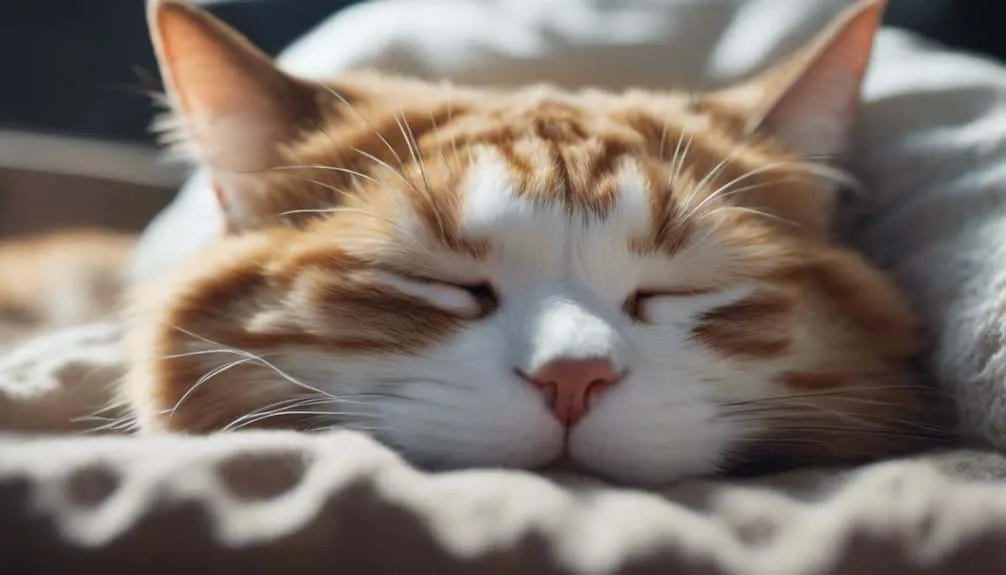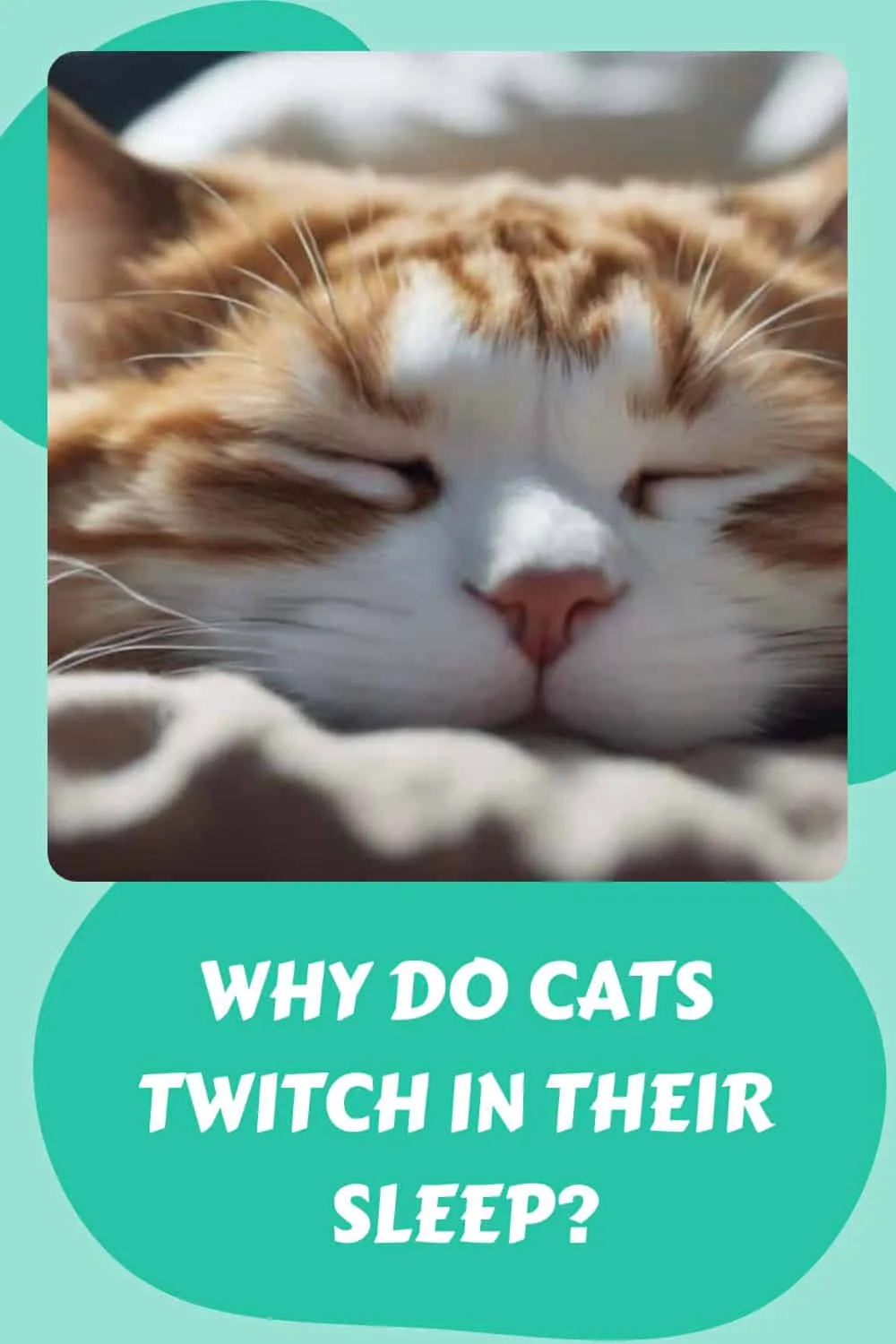The Best Fluffy Pancakes recipe you will fall in love with. Full of tips and tricks to help you make the best pancakes.

Did you know that cats twitch in their sleep due to a fascinating connection between their dreams and instinctual behavior? Understanding why cats exhibit these twitching movements during sleep can provide valuable insights into their inner world and emotional state. As you explore the reasons behind this intriguing behavior, you'll gain a deeper appreciation for the complexity of your feline friend's sleep cycle and the significance of their dream experiences.
Key Takeaways
- Cats twitch in their sleep to prevent muscle atrophy and maintain muscle tone.
- Twitching movements during sleep suggest engagement in dream scenarios.
- Twitching behavior in cats offers insights into their mental and emotional well-being.
- Twitching or jerking movements in cats are linked to their instinctual hunting and stalking behaviors.
- REM sleep, characterized by heightened brain activity, plays a crucial role in feline cognitive function and emotional regulation.
The Physiology of Cat Twitching
When observing the physiology of cat twitching, it becomes evident that these involuntary movements serve various functions during their sleep cycles. Cats go through different stages of sleep, including REM (rapid eye movement) and non-REM sleep.
During REM sleep, which is associated with vivid dreams in humans, cats experience increased brain activity similar to when they're awake. However, their bodies are in a state of muscle relaxation, except for the twitching behavior seen in their paws, whiskers, and tails.
This muscle twitching is believed to help prevent muscle atrophy and maintain muscle tone, ensuring that their muscles remain healthy and functional even during deep sleep cycles.
Understanding the relationship between sleep cycles, brain activity, muscle relaxation, and twitching behavior in cats can provide valuable insights into their overall well-being. By observing these physiological processes, pet owners and caregivers can better support their feline companions' health and make sure they get the restorative sleep they need to thrive.
Dreaming and Twitching Behavior
As we explore the connection between dreaming and twitching behavior in cats, it becomes apparent that these involuntary movements play a significant role in their sleep patterns and overall physiological well-being.
Dream interpretation in cats is a topic that intrigues many pet owners. When your feline friend twitches during sleep, it could be indicative of their dream state. Just like humans, cats experience different sleep stages, including REM (rapid eye movement) sleep, where dreaming commonly occurs.
Twitching movements observed in cats during this phase suggest that they might be actively engaged in dream scenarios, perhaps chasing imaginary prey or engaging in playful interactions. Understanding these sleep behaviors can offer insights into your cat's mental and emotional well-being. It provides a glimpse into their inner world and helps interpret aspects of their cat psychology.
Instinctual Responses in Sleep
Instinctual responses during sleep reveal fascinating insights into a cat's primal behaviors and survival mechanisms. Cats exhibit various sleep signals that are deeply rooted in their evolutionary behavior. These responses serve vital functions in ensuring a cat's safety and well-being even while asleep.
One common instinctual response seen in cats during sleep is twitching or jerking movements. These involuntary muscle contractions are believed to be linked to the cat's practice of hunting and stalking prey. Through these movements, cats may be rehearsing their hunting skills even in the safety of sleep, a behavior inherited from their wild ancestors. Additionally, during sleep, cats often seek out warmth and comfort, which is why do cats sleep between legs. This behavior not only provides them with a cozy spot but also allows them to feel secure and protected, mimicking the closeness they would have experienced in a den with their littermates. As they drift in and out of slumber, their instincts remain sharp, ready for action at a moment’s notice.
Moreover, other instinctual responses observed in cats during sleep include ear movements, whisker twitches, and even vocalizations. These behaviors serve as a way for cats to remain alert and responsive to their surroundings, showcasing their innate ability to react swiftly to potential threats, even when in a state of rest.
Understanding these instinctual responses provides valuable insights into the complex nature of a cat's behavior and highlights the intricate connection between their sleeping patterns and survival instincts.
The Role of REM Sleep
Exploring the importance of REM sleep in cats reveals essential insights into their physiological and cognitive functions during rest. REM sleep, or Rapid Eye Movement sleep, is an essential stage in the feline sleep cycle characterized by heightened brain activity. During this phase, cats experience vivid dreams, muscle paralysis, and rapid eye movements.
REM sleep plays a pivotal role in consolidating memory and learning processes in cats. The increased brain activity observed during this stage is believed to facilitate the processing and storage of information gathered while awake. Additionally, REM sleep is thought to contribute to emotional regulation and overall cognitive function in cats.
Studies have shown that disrupting REM sleep can have detrimental effects on a cat's overall well-being, leading to cognitive impairment and behavioral changes. Therefore, ensuring that cats have uninterrupted and sufficient REM sleep is crucial for their physical and mental health.
Understanding the significance of REM sleep provides valuable insights into the complex neurological processes that occur during a cat's rest, highlighting the importance of allowing them to complete their sleep cycles undisturbed.
Understanding Feline Sleep Patterns
Feline sleep patterns offer a fascinating glimpse into the unique ways cats rest and recuperate, shedding light on their natural behaviors and instincts. Cats, like humans, go through different sleep cycles characterized by variations in brainwaves. These cycles help regulate their overall sleep patterns and guarantee they get the rest they need.
Observing your cat's sleeping positions and behaviors can provide insight into their comfort levels and emotional state. From the classic curled-up position to the sprawled-out belly-up pose, each sleeping position can reveal a lot about how your feline friend is feeling. Additionally, cats may exhibit behaviors such as twitching, paw movements, or even soft purring while asleep, all of which are normal parts of their sleep patterns.
Understanding these feline sleep patterns not only allows you to better care for your cat but also deepens the bond between you and your beloved pet.
Frequently Asked Questions
Do All Cats Twitch in Their Sleep?
Yes, most cats twitch in their sleep. This behavior is linked to their sleep patterns and dreaming. It indicates brain activity during the rapid eye movement (REM) stage, where dreams usually occur.
Can Cat Twitching Be a Sign of Health Issues?
If your cat twitches excessively during sleep, it could indicate underlying health issues. Medical concerns, such as sleep disorders or neurological issues, can manifest through abnormal behavior patterns. Consulting a veterinarian for proper diagnosis and treatment is advisable.
Why Do Cats Sometimes Make Noise While Twitching?
When your cat twitches and makes noise in their sleep, it's like deciphering a dream. This behavior can mirror their dream interpretation and reveal insights into their sleep patterns and feline physiology.
Do Kittens Twitch in Their Sleep Differently Than Adult Cats?
Kittens twitch in their sleep differently from adult cats due to their unique sleep patterns. During various development stages, kittens experience rapid eye movement (REM) sleep, where dream cycles are more intense, leading to noticeable twitching movements.
Can Cat Twitching Be Influenced by Their Environment?
In the domain of feline slumber, your cat's twitching may reflect their sleep patterns and stress levels. Dream content can play a role, as can room temperature. Pay attention to these factors for a peaceful kitty.
Conclusion
You may question the significance of observing your cat's twitching movements during sleep. However, understanding this behavior can provide valuable insights into your feline companion's mental and emotional well-being.
By recognizing the connection between their dreaming experiences and twitching behavior, you can gain a deeper appreciation for the complexities of their inner world. Paying attention to these subtle cues can strengthen your bond with your cat and enhance your overall relationship with them.










